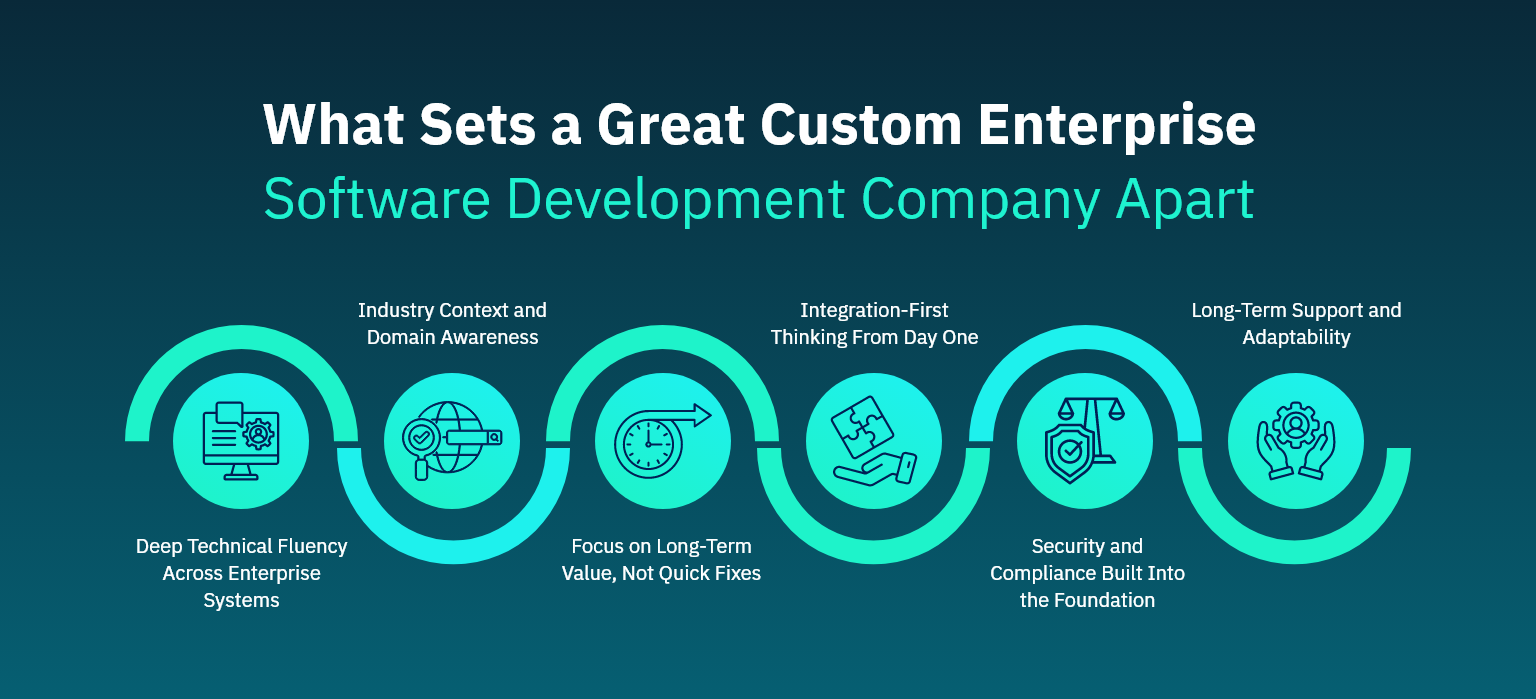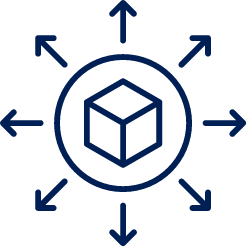
Executive Summary
If you’re leading digital transformation at an enterprise, you already know this: off-the-shelf software rarely fits the way your organization actually operates.
It might check a few boxes at first. However, as your operations become more complex, that quick fix can become a long-term bottleneck. Integrations start to break. Workflows get messy. Teams work around the software instead of with it.
That’s when custom enterprise software moves from a “nice-to-have” to a strategic necessity.
But here’s the catch: choosing to build is only part of the decision; who you build with matters just as much. The wrong partner can hinder your progress, restrict you to rigid architectures, or overlook the nuances that make your business thrive.
In this guide, we’ll help you get clear on:
- When to consider a custom enterprise software development company
- What separates a good development partner from a risky one
- What questions to ask before you commit
- What successful, long-term enterprise-grade software solutions look like in the real world
If you’re evaluating your next software move or questioning whether your current tools can support what’s next, this guide is for you. Let’s start by understanding why more enterprises are walking away from one-size-fits-all software.
I. Why Enterprises Are Shifting to Custom Software
Most enterprise platforms weren’t built for the scale, complexity, and regulatory needs of today’s businesses. They’re effective in many cases, especially if you have standard workflows or predictable growth.
But they often fall short when operations expand across regions, compliance becomes non-negotiable, or data must flow seamlessly across multiple systems. That’s why more enterprises are reconsidering their reliance on one-size-fits-all tools.
For some, off-the-shelf remains sufficient; for others, custom solutions are becoming a strategic choice. The difference usually comes down to the following factors:
1. Competitive Differentiation Requires Unique Capabilities
In crowded markets, using the same tools as everyone else may limit how far you can stand out. Tailored platforms allow organizations with distinctive processes or customer models to embed that uniqueness directly into their software.
2. Real-Time Decision-Making Demands Purpose-Built Systems
In industries where time matters, like predictive maintenance in manufacturing or dynamic pricing in retail, generic systems often can’t process data at the required speed or scale. Purpose-built architectures give enterprises the responsiveness they need.
3. Compliance and Security Demand Precision
For regulated sectors, shifting standards mean systems must be audit-ready by design. Enterprise-grade software solutions can embed compliance controls and reporting workflows tailored to an industry’s specific needs.
4. External Roadmaps Limit Agility
Off-the-shelf platforms evolve on the developer’s schedule, not yours. Enterprises that need to move faster or experiment with new offerings often turn to tailored business applications to control their timelines and deliver results.
II. How to Decide if Custom Software Is Right for You (Or If It Isn’t)
Bespoke enterprise software isn’t always the first or only answer. In many cases, off-the-shelf platforms are not only cheaper and faster but also the most practical choice. They come with proven workflows, community support, and regular vendor updates, which can reduce the burden on internal IT teams.
They tend to work best when:
- Your processes are fairly standard (like payroll, CRM, or HR management)
- Speed and budget are higher priorities than customization
- You need a tool that “just works” without heavy maintenance
But there are also clear situations where custom development becomes a smarter path forward. Think of it less as “better vs. worse” and more as “fit for purpose”.
Here are some indicators that your business may be reaching that point:
- Your Tools No Longer Fit Your Workflows : If your teams are relying on manual exports, endless spreadsheets, or workarounds just to keep things moving, it’s a sign your processes have outgrown the software.
- Disconnected Systems Are Creating Blind Spots : When data lives in silos, reports don’t match, or decisions require hours of reconciliation, integration gaps are holding you back.
- Platform Rules Dictate How You Work : If rigid permissions, missing features, or compliance limitations force your teams to adapt to the tool instead of the other way around, the platform is shaping your business instead of supporting it.
- Compliance and Audit Readiness Are Painful :
When every regulation update or audit turns into a scramble for data, your systems aren’t aligned with your compliance needs. - Temporary Fixes Are Becoming Permanent : If quick fixes, manual patches, or shadow IT solutions keep piling up, it’s a sign your current platform can’t scale with your business.
Plug-ins and patches can buy time, but if they’re propping up critical workflows, it’s worth rethinking whether the foundation is solid enough for the future.
If these challenges sound familiar, the real task is choosing the right custom enterprise software development company to partner with. Here’s what to look for.
III. What Sets a Great Custom Enterprise Software Development Company Apart

Choosing to build custom software is a big decision. Choosing who builds it is even bigger.
Not all partners bring the same mindset, capabilities, or long-term value to the table. The difference between a functional app and a scalable product often comes down to the development partner behind it.
Here’s what truly sets a top-tier custom enterprise software development company apart, and what you should look for before making that call.
- Deep Technical Fluency Across Enterprise Systems
It’s not enough to know how to write clean code. A good partner understands how to architect enterprise-grade software solutions that are modular, scalable, and integration-ready from day one.
Look for:
- Experience with microservices, event-driven systems, and hybrid cloud environments
- Mature DevOps practices, including CI/CD pipelines and test automation
- Clear thinking around technical debt, maintainability, and version control
Great partners don’t just build, they build with scale, stability, and security in mind.
- Industry Context and Domain Awareness
Software doesn’t live in a vacuum. Building for a healthcare provider is vastly different from building for a logistics platform or financial institution. A strong development partner understands the operational realities of your industry and bakes that into the solution.
Look for:
- Familiarity with your industry’s regulations, standards, and workflows
- Case studies or examples from similar verticals
- The ability to ask the right questions during discovery, not just take requirements at face value
Domain awareness ensures you’re not educating your partner on the basics, and it often means faster, more relevant solutions.
- Focus on Long-Term Value, Not Quick Fixes
You don’t want a team that only focuses on getting to “done.” You want one that thinks in terms of long-term outcomes, user adoption, ROI, and platform evolution.
Look for:
- Teams that invest in discovery, user journeys, and real usage scenarios
- Roadmap thinking that goes beyond version 1.0
- A willingness to push back when something doesn’t make sense for scale
The best partners co-create with you, not just deliver a spec.
- Integration-First Thinking From Day One
Your new platform won’t exist in isolation. It needs to integrate seamlessly into your tech stack, encompassing CRMs, ERPs, analytics tools, mobile apps, and custom middleware.
Look for:
- Proven experience in API design, data migration, and system integration
- The ability to work with legacy systems where needed
- A clear strategy for avoiding siloed data or disconnected workflows
Great tailored business applications don’t just work well on their own but make everything else work better, too.
- Security and Compliance Built Into the Foundation
Whether you’re handling personal health data, financial records, or internal IP, security is foundational.
Look for:
- Experience with your specific compliance requirements (HIPAA, SOC 2, GDPR, etc.)
- Role-based access, audit trails, and secure data workflows are built into the core design
- A track record of building resilient, well-documented systems
With the right partner, bespoke enterprise software meets your security needs and reinforces trust at every level.
- Long-Term Support and Adaptability
The work doesn’t end at launch. Platforms evolve, features get prioritized, and teams change. Your partner should offer stability for that evolution, not vanish after the handoff.
Look for:
- Post-launch support models that go beyond bug fixes
- Upgrade paths and documentation that allow internal teams to scale with the product
- A mindset of shared ownership, not just deliverables
The right custom enterprise software development company brings more than engineers to the table. They bring architecture expertise, product thinking, and the ability to see 10 steps ahead. You’re investing in a long-term relationship with people who understand your business and its needs.
That’s the difference between software that scales and software you replace in a year.
IV. Questions to Ask Before Choosing a Custom Software Partner
Once you’ve decided to pursue a custom solution, the next step is identifying the right partner to build it.
But not every vendor that calls itself a custom enterprise software development company is equipped to handle complex enterprise needs.
The right questions can reveal how a partner thinks, whether they truly understand enterprise realities, and how well they’ll align with your long-term goals.
Here are key questions to ask, along with what strong answers should sound like.
FAQ’s
Why it matters: Your business will evolve. The software should, too.
Look for a clear explanation of how they design systems to support scalability, modularity, and future upgrades. It’s a bonus if they proactively mention microservices, cloud readiness, or integration patterns.
Why it matters: Technology should serve real needs, not assumptions.
Look for a discovery phase with stakeholder interviews, user research, and current-state assessments. The best partners won’t jump into code until they understand what your teams actually need.
Why it matters: No enterprise builds from scratch. Integration is non-negotiable.
Look for specifics about past integrations, preferred tools, and how they handle data migration, security, and testing across environments.
Why it matters: You’ll need updates, optimizations, and ongoing improvements after launch.
Look for post-launch support plans, clear ownership handoffs, version control strategies, and options for future collaboration. Avoid vendors who disappear after delivery.
Why it matters: Weak security planning leads to future risk and rework.
Look for familiarity with your industry’s compliance requirements, security-first development practices, and proactive testing and documentation.
Why it matters: Delivery isn’t the finish line. Adoption, performance, and business outcomes matter more.
Look for KPIs tied to performance, usability, and value delivered. Top-tier partners will care about what the software enables, not just whether it shipped.

Asking the right questions helps you assess a potential partner’s capabilities and understand their approach. And that mindset will shape every step of the engagement
V. How Enterprises Across Industries Address Complex Challenges with Custom Software
Off-the-shelf software often fails to meet the demands of complex, fast-moving enterprise environments. That’s why organizations across industries are turning to custom solutions built around their workflows, infrastructure, and compliance needs.
The examples below illustrate how enterprises are using tailored business applications to improve performance, reduce inefficiencies, and support long-term growth, with measurable results.

Healthcare
Hospitals and care networks are streamlining discharge planning, medical record sharing, and compliance reporting through tailored platforms. Custom software enables automated documentation, EMR integrations, and secure handling of patient data, reducing delays and allowing clinicians to focus on patient care.
Case Study: Streamlining Discharge Management for MaxMRJ
Challenge
Hospitals and skilled nursing facilities relied on spreadsheets, emails, and binders for discharge planning, which caused delays, miscommunication, and compliance risks. The lack of EMR integration made secure data sharing difficult, and coordinating with hospice providers was time-consuming, which in turn affected patient transitions and outcomes.
Solution
Matellio partnered with MaxMRJ to design and implement a HIPAA-compliant discharge planning platform. The system integrates with EMRs, securely aggregates patient data, enables real-time communication between hospitals and care providers, and automates tasks, documentation, and referral tracking to reduce manual errors and speed up discharges.
Impact
- Streamlined workflows: Centralized discharge management
- Faster discharges: Reduced delays with automation and tracking
- Optimized referrals: Efficient coordination with care facilities
- Improved compliance: Secure, HIPAA-ready integrations
- Reduced manual errors: Less admin burden, more accuracy
Result: A centralized, automated platform that replaces fragmented workflows, accelerates discharges, and supports smoother, safer care transitions.

Software and SaaS
Growing SaaS companies address scaling challenges with custom integration layers and unified data platforms. By closing gaps between CRMs, billing systems, and analytics tools, they achieve operational efficiency, accelerate feature rollouts, and support global expansion.
Case Study: Building a Scalable Salesforce Integration Platform for Ostrij
Challenge
Ostrij needed a flexible, high-performance solution to connect Salesforce with enterprise tools like Slack, Shiftboard, Workfront, JIRA, and QuickBooks. Businesses relying on these platforms struggled with fragmented data, manual processes, and delays in decision-making. Without centralized integration management, workflows remained siloed, resulting in operational bottlenecks and limited real-time visibility.
Solution
Matellio partnered with Ostrij to develop a powerful, multi-connector integration platform. A centralized dashboard enabled businesses to manage data mapping, synchronization flows, and reporting with ease. Using a mix of batch flow and webhook-based architecture, the platform ensured real-time synchronization across applications. REST API connectivity and AWS ELB load balancing delivered scalable performance, high availability, and reduced latency—transforming Ostrij into an enterprise-grade integration solution.
Impact
- Integrated 19+ Salesforce connectors to expand interoperability across enterprise tools.
- Built and optimized 4 key synchronization workflows to streamline operations.
- Enabled real-time connections between Salesforce and third-party applications, ensuring up-to-date data at all times.
- Reduced manual processing tasks, allowing teams to focus on decision-making rather than data entry.
- Delivered clearer, unified visibility into enterprise data, supporting faster and more accurate business insights.
Result: Ostrij now offers a seamless integration platform that eliminates silos, accelerates processes, and supports enterprise-scale decision-making.

Financial Services
Banks and lenders are modernizing loan and mortgage systems with custom-built applications that replace outdated workflows. Automated approvals, integrated compliance checks, and digitized document handling accelerate decision-making while reducing operational costs.
Regions Bank, a major U.S. regional bank, partnered with Matellio to modernize mortgage and loan processing. By implementing a scalable calculations engine, streamlining data flows, and automating compliance exports, the bank cut manual effort and improved reporting accuracy.

Telecom and Connectivity
Telecom enterprises manage vast, distributed infrastructure using custom monitoring and performance platforms. Real-time analytics, predictive maintenance tools, and integrated dashboards deliver stronger uptime, better resource planning, and faster service delivery.
Hewlett-Packard Enterprise partnered with Matellio to build a real-time 5G observability framework tailored for cloud-native applications. By integrating tools like Jaeger for tracing, live metrics dashboards, and advanced logging systems, HPE gained deep visibility into microservices and network workflows across more than 170 countries. This helped reduce latency, accelerate debugging, and improve system reliability, something off-the-shelf monitoring tools weren’t designed to handle at that scale.

Logistics and Supply Chain
Custom logistics systems bring real-time tracking, predictive analytics, and automated compliance reporting into a single view. Enterprises use these tools to boost fleet utilization, reduce shipment costs, and streamline fulfilment while maintaining transparency throughout the supply chain.
Inseego, a leader in 5G and IoT telematics, partnered with Matellio to enhance real-time fleet tracking. By automating data pipelines, optimizing processing, and improving compliance workflows, the platform was able to scale to larger fleets with improved location accuracy.

E-Commerce and Retail
In online retail, personalization and seamless experience are growth levers. Custom software is helping brands rebuild their checkout flows, unify CRM and inventory data, and support features such as saved favorites, real-time stylist interaction, and video-based product previews. These improvements not only boost sales but also reduce cart abandonment and increase brand loyalty over time.
MIXT Solutions partnered with Matellio to develop a custom inventory management system designed to address performance issues, cost inefficiencies, and scalability challenges in their existing infrastructure. The solution incorporated advanced microservices architecture, seamless integrations with e-commerce platforms, and workflow automation, resulting in 100% uptime, a 75% reduction in processing times, and improved operational efficiency. This transformation allowed MIXT to handle significantly higher order volumes, automate manual tasks, and scale their operations with ease, delivering substantial cost savings and enhancing customer satisfaction.
Public Sector and Compliance-Driven Organizations

Regulatory bodies and public service agencies are using custom platforms to automate citizen complaint handling, financial claim management, and multilingual support. With AI-powered chatbots, case tracking, and real-time analytics, these systems replace manual paperwork and outdated portals with fast, transparent digital services that scale efficiently, especially during high-volume periods.
With these use cases, one thing is clear: across industries, enterprises aren’t settling for workarounds; they’re using custom software to tackle challenges that off-the-shelf tools were never designed to solve.
However, solving these challenges begins with a strategy that’s tightly aligned with the business’s growth plans.
VI. Aligning Software Strategy with Business Growth
Investing in bespoke enterprise software is more than a technical initiative. It’s a long-term business decision. And like any strategic investment, it should reflect where your company is headed, not just what’s broken today.
Many organizations jump straight into solving departmental issues without first considering how the software will support broader goals, such as growth, agility, or operational efficiency.
Here’s how forward-looking enterprises align their software strategy with long-term growth:
Define the Business Outcome First
Before writing a single line of code, teams need clarity on what the software is actually supposed to achieve. Is the goal to onboard customers faster? Improve internal decision-making? Reduce friction across teams or markets?
By defining success in business terms, such as revenue, retention, compliance, and cost savings, you provide your development partner with the necessary context to architect the right solution from the ground up.
Design Software Around Workflows, Not Departments
Software should follow how work actually gets done. Instead of building tools around isolated departments, focus on cross-functional workflows, such as lead-to-close, claim-to-resolution, and dispatch-to-delivery.
This approach reduces handoff friction, improves visibility, and drives efficiency where it matters most.
Build for Change, Not Just Scale
It’s one thing to build a system that can handle more users. It’s another to make one that can evolve with changing regulations, shifting customer needs, or new product lines.
That’s why growth-aligned software emphasizes modular design, API-first development, and infrastructure that can flex across geographies or use cases. It’s about creating a tailored business application that’s ready to support the next phase, whatever that looks like.
Involve the Right Stakeholders Early
The best software strategies include voices beyond engineering. Bring in ops leaders, business owners, and end users early in the process. They help clarify priorities, surface edge cases, and ensure the final product works in the real world, not just in documentation.
Track the Right Metrics Post-Launch
Growth strategies shift, and so should your software. That’s why tracking the right metrics post-launch is just as important as defining them upfront. Whether it’s time saved, tickets resolved, or revenue unlocked, consistent measurement helps you adapt the solution over time and continue delivering value.
However, achieving this requires more than just technical execution. It requires a development partner who understands your industry, collaborates closely with your teams, and co-creates solutions that evolve in tandem with your business.
VII. What a Strategic Development Partnership Should Look Like
Custom software is only as strong as the partnership behind it. For enterprise teams, the real value lies in having a custom enterprise software development company that understands your goals, challenges your assumptions, and builds for long-term impact, not just launch day.
That’s precisely where Matellio steps in.
We work as an extension of your team, from initial discovery to scalable architecture to post-launch optimization. Instead of just delivering code, we help you prioritize features that move the needle, design for scale from the outset, and measure success based on outcomes like efficiency gains, faster workflows, and long-term ROI.
Whether you’re modernizing critical infrastructure or launching bespoke enterprise software, we bring the product mindset, industry experience, and technical depth to build solutions that grow with your business.
VIII. Turning Strategy Into Software That Actually Scales
The enterprises that lead markets don’t rely on generic tools to solve complex problems. They invest in software that accurately reflects how their business operates and how it needs to evolve. It’s how future-ready companies reduce inefficiencies, unlock growth, and maintain control over their infrastructure.
If you’re planning to scale, modernize, or launch something new, don’t start with features. Start with a software partner who understands your vision and knows how to build solutions that deliver lasting value.
Ready to engineer your growth?
Discover how Matellio can streamline your operations and provide your business with a competitive edge.
Schedule a free consultation call with our experts.
Key Takeaways
- Custom enterprise software is a strategic necessity for enterprises whose growth is constrained by the limitations of off-the-shelf solutions.
- Clear indicators that you need a custom software partner include workflow inefficiencies, a lack of integration, platform constraints, and systems that are unable to scale with business growth.
- A top-tier custom enterprise software development company offers deep technical fluency, industry-specific domain knowledge, integration-first thinking, and security built into the core.
- The right partner focuses on long-term value, not just delivery, offering ongoing support, adaptability, and a roadmap for future innovation.
- Industry-specific success stories (healthcare, finance, telecom, logistics, SaaS, retail, public sector) show how tailored platforms can streamline operations, improve compliance, and unlock new revenue streams.
- Aligning your software strategy with business goals ensures solutions are built for change, scale, and cross-functional workflows, not just immediate fixes.
- Strategic partnerships look beyond coding, acting as co-creators who understand your market, challenge assumptions, and design for sustainable growth.
FAQ’s
If your current tools are slowing workflows, lack essential integrations, can’t scale with demand, or require constant workarounds, it’s time to consider a custom build.
Look for partners with proven technical expertise, industry-specific experience, integration capabilities, security compliance, and a track record of delivering long-term value, not just project completion.
Timelines vary based on complexity, integrations, and compliance needs. Small to mid-scale projects typically take 4 to 6 months, while enterprise-wide platforms can extend to 12 months or more.
Custom platforms are designed to fit your exact workflows. They reduce inefficiencies, eliminate redundant costs, enhance user adoption, and create competitive advantages that drive measurable revenue growth.
Prioritize alignment with your business goals and workflows, not just technical skills. The right partner will invest time in understanding your operations, offer strategic input, design for adaptability, and ensure the solution delivers measurable ROI while supporting future innovation.
Got more questions? Schedule a call with our experts to discuss how AI can improve your healthcare system.


